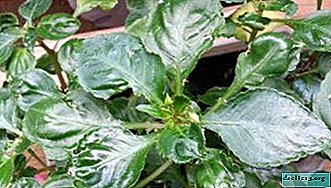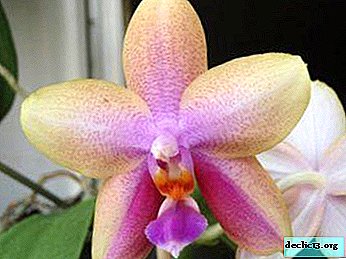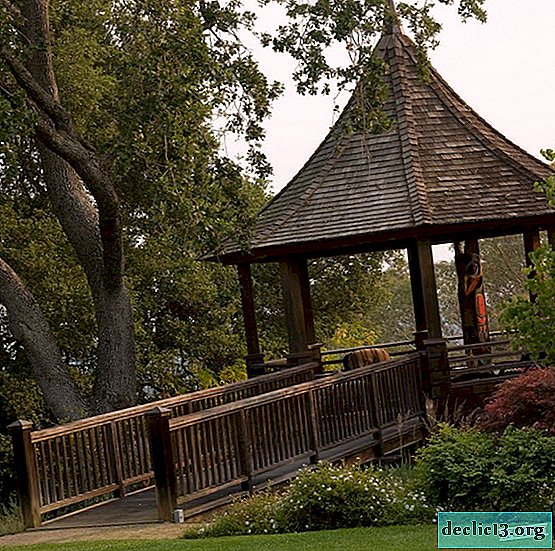What does geranium signalize with spots on the leaves?
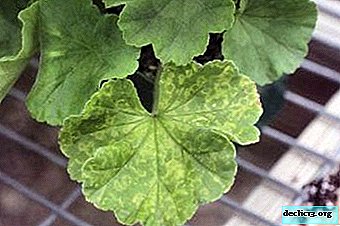
Blooming and fragrant geraniums adorn many windows and balconies due to the variety and beauty of the flowers.
In general, this is a fairly unpretentious plant, but sometimes it suddenly starts to hurt, spots appear on its leaves.
But you can avoid the disease and death of the plant, if you diagnose the problem on time.
Why is this happening, how to deal with misfortune, so as not to lose geraniums and
how to avoid this - find out in this article.
Growth Features
Geranium is generally unpretentious. She loves warmth, sun and simple soil. The conditions for its maintenance are simple:
- moderate watering;
- bright sun (9 out of 10 points);
- warm air;
- good drainage and loosening of the soil;
- nitrogen-phosphorus-potassium fertilizers in equal proportions and very small quantities;
- not very nutritious soil with slightly acidic pH;
- weeding from weeds;
- periodic cutting of upper shoots, removal of dead flowers and leaves.
Diagnosis of problems
Small light spots
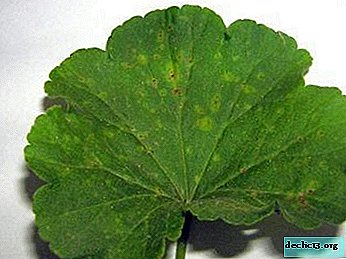 Clearly outlined yellow spots on the top of the leaf, and a brown rash in the same places on the back. This is rust, it appears with excess moisture and high air temperature.
Clearly outlined yellow spots on the top of the leaf, and a brown rash in the same places on the back. This is rust, it appears with excess moisture and high air temperature.- Light spots and fluff on the leaves, the plant becomes sluggish, dark spots appear on the stems - this is Botrytis fungus. The reasons are excess moisture.
- Pale green spots on leaves with a circular pattern, which subsequently merge, geranium does not bloom and does not develop, the stems are curved and white stripes appear on the flowers - this is an annular spotting that is spread by nematodes living in the soil.
- Yellow spots on the leaves on the back side, the leaves fall off, the flower is entangled in fluff - this is a defeat by a spider mite.
Brown patches
- Brown spots on the lower leaves of geraniums may indicate infection with gray rot. These spots are the first symptom, followed by a dense gray coating on the affected areas.
- Brown spots with a bright middle are a sign of alternariosis. Manifestations of the disease: geranium does not bloom, the leaves turn yellow and dry, and with increased humidity, a velvet coating appears on them.
- Brown-red spots on the leaves and stem - geraniums are cold or too much sun (about why room geraniums turn red and dry, read here). You should move the geranium to a warmer place and choose the optimal level of lighting - 9 out of 10 points.
Causes of the disease
On a note. Common causes of discoloration of geranium leaves are associated with improper care.- Yellowness on the leaves of geranium appears with the following errors:
- insufficient watering of the plant (when only the edges of the leaves turn yellow);
- on the contrary, excessive watering (if yellow spots appeared against a background of progressive lethargy of the plant);
- lack of sun (while the leaves are not only covered with yellow spots, but also fall off).
- In addition to infections and parasites, brown spots on the leaves of geraniums appear:
 placing the flower in a too tight pot;
placing the flower in a too tight pot;- lack or insufficient drainage in it;
- draft;
- lack of sunlight and / or heat;
- excess nitrogen fertilizers to the detriment of phosphorus and nitrogen;
- landing in street soil without its preliminary processing.
- transfer geraniums to a cool and dry place;
- reduce watering and stop spraying;
- remove diseased leaves;
- treat the plant with Topaz.
- remove affected plant fragments;
- treat it with systemic fungicides;
- reduce watering;
- loosen the soil.
- rinse the flower with warm water with household or tar soap - after this, half of the tick population will be destroyed;
- sanitize the windowsill and everything that was there, wash the windows, wash the curtains;
- water the geranium well and wrap it tightly with polyethylene for three days - the mites will die from high humidity.
- treat geraniums with systemic fungicides to kill the fungus;
- reduce watering, cancel spraying, reduce air humidity.
- replacement of earth and pot;
- processing plants with Ridomil Gold or Skor;
- good ventilation;
- loosening the soil;
- optimal irrigation mode.
- rinse the flower in a soap-and-ash solution;
- wipe the leaves with alcohol - this must be done quickly so as not to burn them;
- treat with special insecticides;
- replace the soil.
- correct temperature conditions;
- certain soil moisture;
- optimal lighting;
- timely top dressing.
The appearance of spots on the leaves of geraniums can cause aphids, whitefliespowdery worm and other parasites.
What to do if the flower is sick: detailed instructions
The main condition is to create quarantine so that the disease does not spread to other flowers. A careful examination of the leaves on the upper and lower sides, the stem, flowers, soil and assessment of the condition can give a lot of information about what happened to your geranium.
Rust
If the flower is affected by rust, it is necessary:
Fungus
If symptoms indicate Botrytis, you will have to:
Ring spotting
If ring spotting is detected, it is unlikely to save the flower. The disease is viral and affects the entire plant.Therefore, the prognosis is most often unfavorable, and it is better to destroy the plant along with the ground.
Spider mite
 Getting rid of the spider mite is possible if the owner is ready to devote a lot of effort to this. A tick is a microscopic arachnid, not an insect. Fighting insecticides is useless.
Getting rid of the spider mite is possible if the owner is ready to devote a lot of effort to this. A tick is a microscopic arachnid, not an insect. Fighting insecticides is useless.
How to get rid of a spider mite:
Some gardeners recommend a tincture of garlic in water to enhance the effect, followed by wrapping: cotton swabs are moistened with caustic solution and laid out for 2-3 on each pot.
Also are considered very effective spraying with aspirin (1 tablet per 1 liter of water). You can do without wrapping, using insectoacaricidal preparations every 2 weeks. However, they affect only adults. To stop the appearance of eggs, it is necessary to use hormonal preparations (clofentesin and flufenzin), and for a more powerful effect, combine them with any biological product.
If everything has been tried, but the pest does not give up, you can let a natural enemy attack him, who will gladly destroy mites from small to large, but will not touch either your flowers, animals or yourself: this is phytoseyulus. During the day, he destroys up to five adults or up to a dozen eggs, and left without food, dies. You can buy it at a garden center, flower shop or online.
Attention! If the cobweb entangled the entire plant, it can no longer be saved.Gray rot
How to cure gray rot:
Alternariosis
 Infection with this disease occurs through the ground. Treatment:
Infection with this disease occurs through the ground. Treatment:
Insects
If geraniums are defeated by parasite insects, they can be deduced in one of the following ways:
Prevention
The plant is quite resistant to disease, but prevention will help to avoid unnecessary problems. It is necessary to monitor the condition of the flower and maintain:
So, geranium is not the most difficult flower to care for and maintain, but it also needs attention and care. By being vigilant to the condition of leaves, flowers, and stems, you can significantly extend the life of geraniums, and it will adorn your home for a long time with lush flowering or an invigorating aroma of leaves.

 Clearly outlined yellow spots on the top of the leaf, and a brown rash in the same places on the back. This is rust, it appears with excess moisture and high air temperature.
Clearly outlined yellow spots on the top of the leaf, and a brown rash in the same places on the back. This is rust, it appears with excess moisture and high air temperature. placing the flower in a too tight pot;
placing the flower in a too tight pot;











